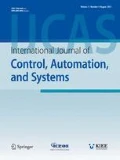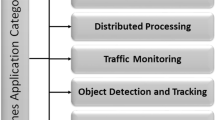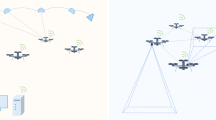Abstract
Swarm robotics is an approach to realizing an intelligent system using swarm intelligence that emerges from complex interactions among individual robots. To implement a swarm robot system requires an efficient method for sharing and utilizing the information that is gathered by multiple robots. In this paper, we propose an algorithm to gather, simplify, share, and use the information in a multi-purpose swarm robot system. To minimize communications traffic among the robots, we use a graph-based map-building method. Furthermore, the nodes on the graph include information about the environment for control and interaction among the robots. We refer to this graph-based map as a virtual pheromone map. We propose an efficient algorithm to build a virtual pheromone map with low communications traffic and without contradictions using error-included sensors. The utilization method of the virtual pheromone map is efficient for implementing the interactions among the robots. The proposed algorithms are validated by a computer simulation. The result of the simulation shows that the virtual pheromone map-based swarm robot system works efficiently from the effects of swarm intelligence.
Similar content being viewed by others
References
D. Payton, R. Estkowski, and M. Howard, “Compound behaviors in pheromone robotics,” Robotics and Autonomous Systems, vol. 44, no. 3, pp. 229–240, 2003.
J. D. McLurkin, Stupid Robot Tricks: A Behavior-Based Distributed Algorithm Library for Programming Swarms of Robots, M.S. thesis, MIT, May 2004.
S. Kim, K. Shin, C. Woo, Y. Eom, and J. Lee, “Performance analysis of entropy-based multi-robot cooperative systems in a MANET,” International Journal of Control, Automation, and Systems, vol. 6, no. 5, pp. 722–730, 2008.
J.-L. Blanco, J-A. Fernández-Madrigal, and J. Gonzalez, “Toward a unified Bayesian approach to hybrid metric—topological SLAM,” IEEE Trans. on Robotics, vol. 24, no. 2, pp. 259–270, 2008.
M. Golfarelli, D. Maio, and S. Rizzi, “Elastic correction of dead-reckoning errors in map building,” Proc. of IEEE/RSJ International Conference on Intelligent Robots and Systems, vol. 2, 1998.
J. Liu, Y. Zhang, and F. Zhao, “Robust distributed node localization with error management,” Proc. ACM MobiHoc’06. ACM Press, pp. 250–261, 2006.
A. Janchiv, D. Batsaikhan, B. Kim, W. Lee, and S. Lee, “Time-efficient and complete coverage path planning based on flow networks for multi-robots,” International Journal of Control, Automation, and Systems, vol. 11, no. 2, pp. 369–376, 2013.
J. Yu and S. M. LaValle, “Structure and intractability of optimal multi-robot path planning on graphs,” Proc. AAAI National Conference on Artificial Intelligence, 2013.
V. Indelman, P. Gurfil, E. Rivlin, and H. Rostein, “Graph-based distributed cooperative navigation for a general multi-robot measurement model,” The International Journal of Robotics Research, vol. 31, no. 9, pp. 1057–1080, 2012.
D. Kim, “Self-organization of unicycle swarm robots based on a modified particle swarm framework,” International Journal of Control, Automation, and Systems, vol. 8, no. 3, pp. 622–629, 2010.
H. Jung, Y. Kim, and D. Kim, “Visual cooperation based on LOS for self-organization of swarm robots,” International Journal of Control, Automation, and Systems, vol. 11, no. 1, pp. 216–224, 2013.
W. Moon, J. Jang, and K. Baek, “Optimization of code combination in multi-code ultrasonic sensors for multi-robot Systems,” Journal of Institute of Control, Robotics and Systems (in Korean), vol. 19, no. 7, pp. 614–619, 2013.
W. Moon, B. Cho, J. Jang, and K. Baek, “A multirobot positioning system using a multi-code ultrasonic sensor network and a Kalman filter,” International Journal of Control, Automation, and Systems, vol. 8, no. 6, pp. 1349–1355, 2010
K. Choi and S. Lee, “An enhanced CSLAM for multi-robot based on unscented Kalman filter,” International Journal of Control, Automation, and Systems, vol. 10, no. 1, pp. 102–108, 2012.
W. Moon, J. Jang, and K. Baek, “Environment Adaptation using Evolutional Interactivity in a Swarm of Robots,” Journal of Institute of Control, Robotics and Systems (in Korean), vol. 16, no. 3, pp. 227–232, 2010.
W. Moon and K. Baek, “Swarm robot patrol system based on virtual landmark,” Proc. of the 7th Int. Conf. on Ubiquitous Robots and Ambient Intelligence, Busan, Korea, pp. 642–644, 2010.
Author information
Authors and Affiliations
Corresponding author
Additional information
Recommended by Associate Editor Hongbo Li under the direction of Editor Hyouk Ryeol Choi.
This work was supported by BK21PLUS, Creative Human Resource Development Program for IT Convergence.
Woo-Sung Moon received his BS in 2007 and his MS in 2009 and is currently working toward a Ph.D. in the School of Electrical Engineering, Pusan National University. His research interests include collective intelligent systems.
Woo-Sung Moon received his BS in 2007 and his MS in 2009 and is currently working toward a Ph.D. in the School of Electrical Engineering, Pusan National University. His research interests include collective intelligent systems.
Jin-Won Jang received his BS in 2005 and his MS in 2007 and is currently working toward a Ph.D. in the School of Electrical Engineering, Pusan National University. His research interests include vision systems and adaptive control.
Han-Sol Kim received his BS in 2011 and his MS in 2013 and is currently working toward a Ph.D. in the School of Electrical Engineering, Pusan National University. His research interests include digital signal processing and control systems.
Kwang-Ryul Baek received his BS in Electrical and Mechanical Engineering from Pusan National University in 1984. He received his MS and Ph.D. from KAIST. He joined Turbotech Company as the head of development from 1989 to 1994. Now, he is a professor at Pusan National University. His research interests include digital signal processing, control systems, and high-speed circuit systems.
Rights and permissions
About this article
Cite this article
Moon, WS., Jang, JW., Kim, HS. et al. Virtual pheromone map building and a utilization method for a multi-purpose swarm robot system. Int. J. Control Autom. Syst. 13, 1446–1453 (2015). https://doi.org/10.1007/s12555-013-0431-z
Received:
Revised:
Accepted:
Published:
Issue Date:
DOI: https://doi.org/10.1007/s12555-013-0431-z




